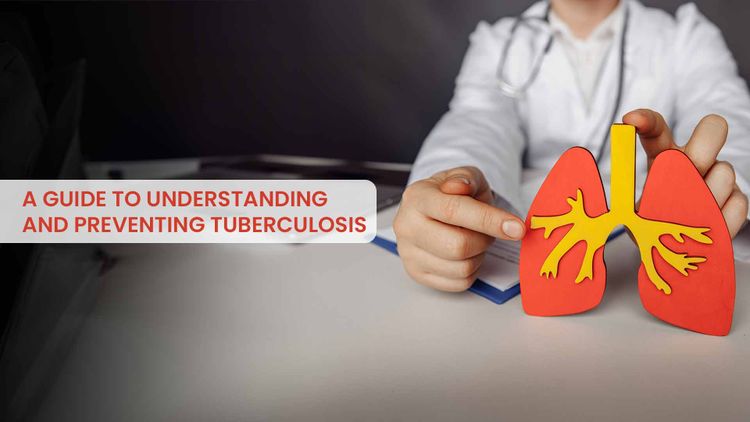
A Guide to Understanding and Preventing Tuberculosis
By Dr. Vivek Kumar Verma in Pulmonology
Apr 01 , 2024 | 3 min read
Your Clap has been added.
Thanks for your consideration
Share
Share Link has been copied to the clipboard.
Here is the link https://www.maxhealthcare.in/blogs/overview-of-tuberculosis-and-prevention
Tuberculosis (TB) is an infectious condition that affects the lungs but can also spread to other parts of the body. It can cause damage to tissues and scarring, which contributes to symptoms like a persistent cough, fever, hoarseness, night sweats, chills, shortness of breath, and more.
TB can be transmitted by coming in contact with the droplets of infected people, being around them, especially in crowded areas or even in areas with poor ventilation and hygiene. There are several types of TB, and are generally classified as:
- Pulmonary TB affects the lungs.
- Extrapulmonary TB affects organs other than the lungs, like the brain or kidneys.
- Latent Tuberculosis Infection (LTBI) occurs in individuals with TB bacteria but don't have active TB disease; they are asymptomatic and non-contagious.
- In active TB Disease, the TB bacteria is active. It causes symptoms and requires treatment to prevent transmission and complications.
- Drug-resistant TB occurs when the bacteria develop resistance to antibiotics and require specialized care.
TB can affect anyone - regardless of their gender, social status, and location. The causes of TB can include close contact with infected individuals, weakened immune systems, substance abuse, prior chronic conditions, and travelling to areas of high transmission rates, to name a few.
These factors have given way to the TB vaccine, which in India is called the BCG (Bacillus Calmette-Guérin) vaccine. A national concern, the vaccine is usually administered as babies are born and protects them from severe forms of tuberculosis (TB) and its variants like TB meningitis and miliary TB.
The treatment for tuberculosis (TB) involves a mix of antibiotics taken over several months, as it helps kill the bacteria gradually and prevents the development of antibiotic resistance. Individuals with TB must stick to their treatment regimen and complete their full course of antibiotics. Not completing the treatment or skipping doses could result in ineffective treatment, cause it to fail, or lead to the development of drug-resistant strains of TB, which can be more challenging to treat.
With proper treatment and adherence to medication schedules, most people with TB may be cured. Early diagnosis and immediate treatment are necessary for successful outcomes and to prevent the spread of TB to others. Along with antibiotics, supportive care, like adequate nutrition, rest, and monitoring for side effects of medication, is necessary to support recovery. Regular follow-up appointments with doctors are also important to monitor progress and treatment response and address any complications or side effects that may occur during the course of treatment.
While it is impossible to fully prevent TB, there are things individuals can do to reduce the chances of contracting the disease. Some important ones include:
- Ensuring infants receive the Bacillus (BCG) vaccine is crucial. Vaccination is especially important in regions where TB is prevalent.
- If diagnosed with TB infection or disease, individuals should finish the full course of treatment as prescribed by their doctor to ensure complete recovery and prevent the development of drug-resistant TB.
- It is recommended to cover one's nose and mouth with the elbow or a tissue when sneezing and coughing to help prevent the spread of TB through the air.
- Ensuring adequate ventilation in indoor spaces is essential, especially in crowded or poorly ventilated settings where TB bacteria can thrive.
- Individuals should minimize close contact with individuals known to have active TB disease, especially if they are not receiving treatment.
- If individuals experience symptoms suggestive of TB, such as a persistent cough, fever, weight loss, or night sweats, they should seek medical evaluation and testing promptly.
- Addressing underlying risk factors that may increase susceptibilities to TB, like HIV infection, malnutrition, diabetes, or substance abuse, is important.
- Taking precautions to limit exposure to TB bacteria in high-risk settings like healthcare facilities is advised.
By implementing these preventive measures, individuals can help reduce the risk of TB transmission and protect themselves and others from TB infection and disease.

Written and Verified by:

Related Blogs

Dr. Inder Mohan Chugh In Pulmonology , Health And Wellness
Nov 08 , 2020 | 3 min read

Medical Expert Team
Jun 06 , 2015 | 2 min read
Blogs by Doctor

Lung Cancer Causes, Symptoms, Diagnosis and Prevention
Dr. Vivek Kumar Verma In Cancer Care / Oncology
Nov 09 , 2016 | 3 min read

Protecting Youth from Tobacco: Effective Prevention Strategies
Dr. Vivek Kumar Verma In Pulmonology
May 29 , 2023 | 2 min read
Most read Blogs
Get a Call Back
Related Blogs

Dr. Inder Mohan Chugh In Pulmonology , Health And Wellness
Nov 08 , 2020 | 3 min read

Medical Expert Team
Jun 06 , 2015 | 2 min read
Blogs by Doctor

Lung Cancer Causes, Symptoms, Diagnosis and Prevention
Dr. Vivek Kumar Verma In Cancer Care / Oncology
Nov 09 , 2016 | 3 min read

Protecting Youth from Tobacco: Effective Prevention Strategies
Dr. Vivek Kumar Verma In Pulmonology
May 29 , 2023 | 2 min read
Most read Blogs
- CAR T-Cell Therapy
- Chemotherapy
- LVAD
- Robotic Heart Surgery
- Kidney Transplant
- The Da Vinci Xi Robotic System
- Lung Transplant
- Bone Marrow Transplant (BMT)
- HIPEC
- Valvular Heart Surgery
- Coronary Artery Bypass Grafting (CABG)
- Knee Replacement Surgery
- ECMO
- Bariatric Surgery
- Biopsies / FNAC And Catheter Drainages
- Cochlear Implant
- More...




